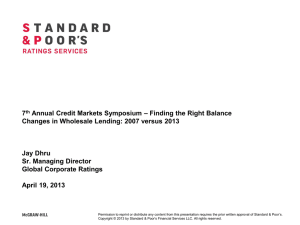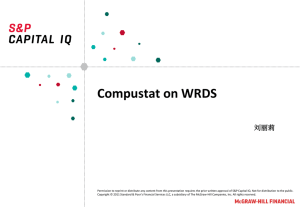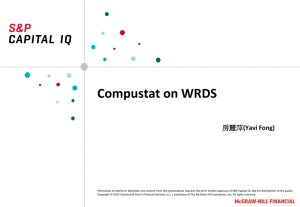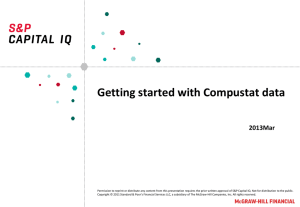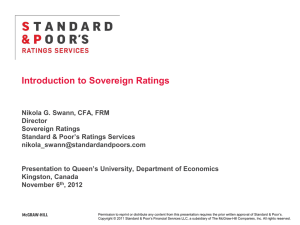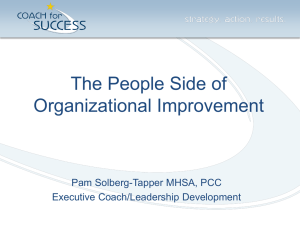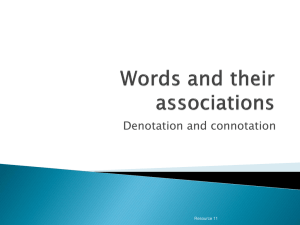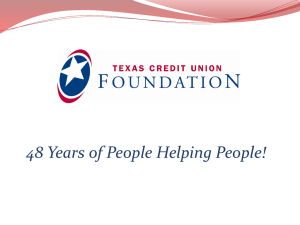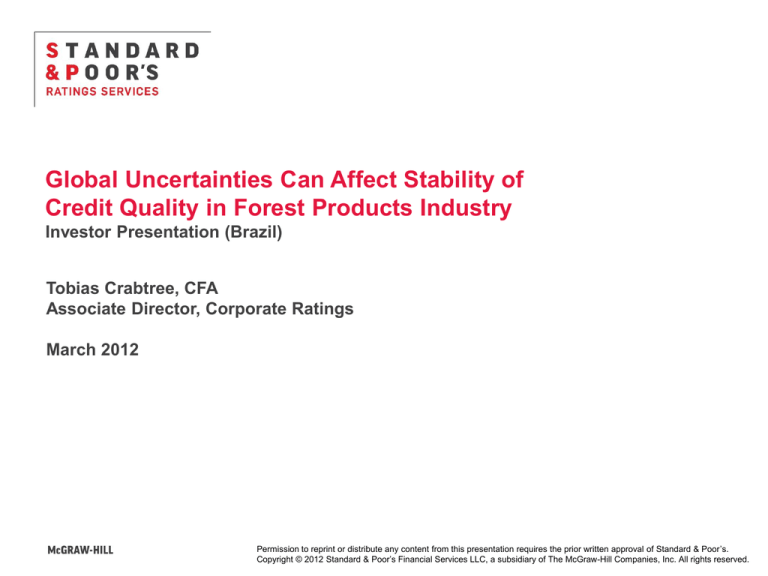
Global Uncertainties Can Affect Stability of
Credit Quality in Forest Products Industry
Investor Presentation (Brazil)
Tobias Crabtree, CFA
Associate Director, Corporate Ratings
March 2012
Permission to reprint or distribute any content from this presentation requires the prior written approval of Standard & Poor’s.
Copyright © 2012 Standard & Poor’s Financial Services LLC, a subsidiary of The McGraw-Hill Companies, Inc. All rights reserved.
Global Forest Products Ratings Outlook Dispersion
Outlook Distribution
(All Issuers)
Stable
71%
Outlook Distribution
(Non-Investment Grade)
Stable
60%
Positive & C.W.
Pos
6%
Negative & C.W.
Neg
23%
Positive & C.W.
Pos
8%
Negative & C.W.
Neg
32%
• Rating outlooks mostly stable for the 55 publicly rated entities
• All of the 15 investment-grade issuers have stable rating outlooks
• Downgrades could outpace upgrades for non-investment grade issuers
– 32% of non-investment grade issuers have negative ratings outlooks or
CreditWatch negative placements
Permission to reprint or distribute any content from this presentation requires the prior written approval of Standard & Poor’s.
2.
Baseline Economic Scenario
• Sluggish economic growth in the U.S.
– Real GDP growth of 2.1% in 2012 and 2.3% in 2013
– Cautious consumer spending outlook
– Total housing starts of 730,000 in 2012 & 990,000 in 2013
• Recession in the Eurozone during the first half of 2012
– Eurozone should gradually climb out of its mild recession in second half of 2012
– Real GDP growth of 0% in 2012 and 1% in 2013
• China growing at a slower pace
– Real GDP growth of 8% in 2012, compared to 9.5% in 2011
• We expect input cost inflation to be less of a headwind than in 2011
– Near-term decreases in pulp & recycled fiber costs
– Higher chemical and petroleum-based input costs
Permission to reprint or distribute any content from this presentation requires the prior written approval of Standard & Poor’s.
3.
Just How Stable Is Credit Quality?
• Most issuers’ financial performance has strengthened post 2008
• Demand risks
– Differs by forest products subsectors
• Supply risks
– New supply additions are targeting growth in Asia and Latin America
• Regional differences in our rating outlooks
– Recession in Eurozone
– Depressed housing market conditions in the U.S.
– Slowing growth in China
– Significant potential capital expansions in Latin America
• Key risks to our rating outlooks
Permission to reprint or distribute any content from this presentation requires the prior written approval of Standard & Poor’s.
4.
Most Issuers’ Financial Performance Has Strengthened Post 2008
• Cash flow from operations has recovered post 2008/2009
recession
– Potentially lower 2012 free cash flow as capital expenditures,
acquisitions & shareholder rewards increase from 2011 levels
• Most companies should have “strong” or “adequate” liquidity
– Companies have strengthened their balance sheets to withstand
systemic shocks & cautious demand environment
– We view refinancing risk over the next 2 years as manageable
• Nine issuers have “less than adequate” or “weak” liquidity
– Concentrated in the ‘CCC’ rating category due to potential covenant
breaches or default risk
Permission to reprint or distribute any content from this presentation requires the prior written approval of Standard & Poor’s.
5.
Demand Risks Differ By Forest Products Subsectors
• Food & beverage packaging and tissue paper sectors relatively more
stable even under a recession scenario
– Food & beverage packaging segments less susceptible to a recession scenario
– Tissue demand driven more by economic and demographic growth
• GDP growth-driven sectors could see some pricing pressure
– Containerboard, paper-based packaging would likely see modest demand
declines with potential for pricing pressure
• Secular demand decline for printing & writing papers could accelerate
– We believe North American & European printing and writing paper demand is
most vulnerable to a recession with the potential for double-digit declines
• Pulp markets driven mostly by global demand
– A “hard landing” in China could pressure global pulp pricing
• A limited improvement in U.S. housing could negatively affect ratings
on wood products companies
Permission to reprint or distribute any content from this presentation requires the prior written approval of Standard & Poor’s.
6.
Demand Risks Differ By Forest Products Subsectors
U.S. & Canadian Forest Products Sector Outlook By Product Type
For The Next 12 Months Vs. The Past 12 Months
Product
Uses
Demand
Pulp
Broad range, including tissue,
Neutral
freesheet paper, specialty papers
Supply
Unfavorable
Pricing
Unfavorable
Containerboard &
Corrugated Products
Packaging containers (i.e., "brown
boxes")
Neutral
Neutral
Neutral
Bleached paperboard
(SBS)
Boxes/cartons/cups/paper plates for
food & consumer products; Packaging
containers
Boxes/cartons for food & consumer
products; Packaging containers
Neutral
Neutral
Neutral
Neutral
Neutral
Neutral
Unfavorable
Neutral
Neutral
Coated groundwood
(CGW)
Commercial printing, direct mail,
brochures, annual reports,
magazines, catalogs
Magazines, catalogs, books, inserts,
coupons, direct mail
Unfavorable
Favorable
Neutral
Uncoated freesheet
(UFS)
Forms, envelopes, printing paper,
office copy paper
Slightly unfavorable
Neutral
Neutral
Newsprint
Newspapers
Unfavorable
Neutral
Neutral
Tissue
Tissues, paper towels
Favorable
Slightly unfavorable
Favorable
Wood products
Logs - housing construction & pulp for
paper mills; Lumber/Panels - housing
construction
Slightly favorable
Slightly favorable
Neutral
Recycled paperboard
(CRB)
Coated freesheet
(CFS)
Permission to reprint or distribute any content from this presentation requires the prior written approval of Standard & Poor’s.
7.
Supply Risks
• Consolidation in North America & Europe supports supply-side
discipline
– North American containerboard largely consolidated following significant
M&A activity in 2011
– Printing and writing papers in North America largely consolidated and
supply is expected to be balanced with demand over the near-term
• New capacity additions occurring in China and Latin America
– China adding significant new paperboard and paper capacity
– Latin America expansions target its low-cost advantage in pulp
– New capacity additions in North America limited to tissue and specialty
pulp
Permission to reprint or distribute any content from this presentation requires the prior written approval of Standard & Poor’s.
8.
Regional Differences In Our Ratings Outlooks
Outlook Distribution
(All Issuers)
Stable
71%
Positive & C.W.
Pos
6%
Outlook Distribution
(U.S. & Canada)
Stable
70%
Negative & C.W.
Neg
23%
Negative & C.W.
Neg
23%
Outlook Distribution
(EMEA)
Stable
80%
Positive & C.W.
Pos
7%
Outlook Distribution
Stable (Latin America)
86%
Positive & C.W.
Pos
10%
Negative & C.W.
Neg
10%
Permission to reprint or distribute any content from this presentation requires the prior written approval of Standard & Poor’s.
9.
Negative & C.W.
Neg
14%
Key Risks To Our Rating Outlooks
• Double-dip economic scenario resulting in reduced demand,
pricing & profitability
– Would expect real GDP to decline 0.2% in U.S. & 2% in Eurozone
• Rise in input costs not able to be offset with price increases
• Pricing deterioration due to supply additions
• More aggressive financial policies (i.e., increased shareholder
rewards and acquisitions)
• Stagnant U.S. housing starts into the 2013 building season
• Global macro events (i.e., Euro banks) could have negative
impact on consumer confidence and demand
• Downgrade pressure more likely to occur for non-investment
grade issuers & wood products focused companies
Permission to reprint or distribute any content from this presentation requires the prior written approval of Standard & Poor’s.
10.
Appendices
Permission to reprint or distribute any content from this presentation requires the prior written approval of Standard & Poor’s.
11.
Global Forest Products Ratings Distribution
8
7
6
# of Issuers
5
4
3
2
1
0
A-
BBB+
BBB
BBB-
BB+
BB
BB-
B+
Rating
Permission to reprint or distribute any content from this presentation requires the prior written approval of Standard & Poor’s.
12.
B
B-
CCC+ or
below
70%+ Of Forest Products Issuers Are Non-Investment Grade
Ratings Category Distribution
(Overall)
Ratings Category Distribution
(U.S. & Canada)
BB
35%
A
2%
A
2%
D
4%
CCC
5%
BB
36%
BBB
29%
BBB
27%
D
4%
B
27%
B
29%
Ratings Category Distribution
(EMEA)
BB
40%
BBB
30%
Ratings Category Distribution
(Latin America)
BBB
29%
BB
57%
B
30%
B
14%
Permission to reprint or distribute any content from this presentation requires the prior written approval of Standard & Poor’s.
13.
Related Criteria And Research
• “Credit Themes: Prospects For U.S. And Canadian Forest
Products Are Stable, But Economic Uncertainty Lingers,” Feb. 7,
2012
• “Industry Economic And Ratings Outlook: A Less Optimistic
Picture For U.S. Natural Resources,” Jan. 26, 2012
• “Issuer Ranking: North American Forest Products Companies,
Strongest To Weakest,” Jan. 9, 2012
• “Latin American Corporates Should Maintain Their Credit
Quality Despite A Sluggish U.S. Economy And Europe’s Debt
Woes—For Now,” Aug. 29, 2011
• “Key Credit Factors: Criteria For Rating The Forest Products
Industry,” Dec. 11, 2009
Permission to reprint or distribute any content from this presentation requires the prior written approval of Standard & Poor’s.
14.
Analysts
• U.S.
– Tobias Crabtree, tobias_crabtree@standardandpoors.com, (212) 438-6503
– James Fielding, james_fielding@standardandpoors.com, (212) 438-2452
• Canada
– Jatinder Mall, jatinder_mall@standardandpoors.com, (416) 507-2544
• Europe
– Jacob Zachrison, jacob_zachrison@standardandpoors.com, +4684405920
• Latin America
– Reginaldo Takara, Reginaldo_Takara@standardandpoors.com, 55-11-3039-9740
– Luciano Gemone, Luciano_Gremone@standardandpoors.com, 54-11-4891-2143
• Asia
– Brenda Wardlaw, brenda_wardlaw@standardandpoors.com, 61-3-9631-2074
Permission to reprint or distribute any content from this presentation requires the prior written approval of Standard & Poor’s.
15.
www.standardandpoors.com
Copyright © 2012 by Standard & Poor’s Financial Services LLC (S&P), a subsidiary of The McGraw-Hill Companies, Inc. All rights reserved.
No content (including ratings, credit-related analyses and data, model, software or other application or output therefrom) or any part thereof (Content) may be modified, reverse engineered, reproduced or
distributed in any form by any means, or stored in a database or retrieval system, without the prior written permission of S&P. The Content shall not be used for any unlawful or unauthorized purposes. S&P, its
affiliates, and any third-party providers, as well as their directors, officers, shareholders, employees or agents (collectively S&P Parties) do not guarantee the accuracy, completeness, timeliness or availability
of the Content. S&P Parties are not responsible for any errors or omissions, regardless of the cause, for the results obtained from the use of the Content, or for the security or maintenance of any data input by
the user. The Content is provided on an “as is” basis. S&P PARTIES DISCLAIM ANY AND ALL EXPRESS OR IMPLIED WARRANTIES, INCLUDING, BUT NOT LIMITED TO, ANY WARRANTIES OF
MERCHANTABILITY OR FITNESS FOR A PARTICULAR PURPOSE OR USE, FREEDOM FROM BUGS, SOFTWARE ERRORS OR DEFECTS, THAT THE CONTENT’S FUNCTIONING WILL BE
UNINTERRUPTED OR THAT THE CONTENT WILL OPERATE WITH ANY SOFTWARE OR HARDWARE CONFIGURATION. In no event shall S&P Parties be liable to any party for any direct, indirect,
incidental, exemplary, compensatory, punitive, special or consequential damages, costs, expenses, legal fees, or losses (including, without limitation, lost income or lost profits and opportunity costs) in
connection with any use of the Content even if advised of the possibility of such damages.
Credit-related analyses, including ratings, and statements in the Content are statements of opinion as of the date they are expressed and not statements of fact or recommendations to purchase, hold, or sell
any securities or to make any investment decisions. S&P assumes no obligation to update the Content following publication in any form or format. The Content should not be relied on and is not a substitute for
the skill, judgment and experience of the user, its management, employees, advisors and/or clients when making investment and other business decisions. S&P’s opinions and analyses do not address the
suitability of any security. S&P does not act as a fiduciary or an investment advisor. While S&P has obtained information from sources it believes to be reliable, S&P does not perform an audit and undertakes
no duty of due diligence or independent verification of any information it receives.
S&P keeps certain activities of its business units separate from each other in order to preserve the independence and objectivity of their respective activities. As a result, certain business units of S&P may
have information that is not available to other S&P business units. S&P has established policies and procedures to maintain the confidentiality of certain non–public information received in connection with
each analytical process.
S&P may receive compensation for its ratings and certain credit-related analyses, normally from issuers or underwriters of securities or from obligors. S&P reserves the right to disseminate its opinions and
analyses. S&P's public ratings and analyses are made available on its Web sites, www.standardandpoors.com (free of charge), and www.ratingsdirect.com and www.globalcreditportal.com (subscription), and
may be distributed through other means, including via S&P publications and third-party redistributors. Additional information about our ratings fees is available at www.standardandpoors.com/usratingsfees.
Permission to reprint or distribute any content from this presentation requires the prior written approval of Standard & Poor’s.
16.
STANDARD & POOR’S, S&P, GLOBAL CREDIT PORTAL and RATINGSDIRECT are registered trademarks of Standard & Poor’s Financial Services LLC.

